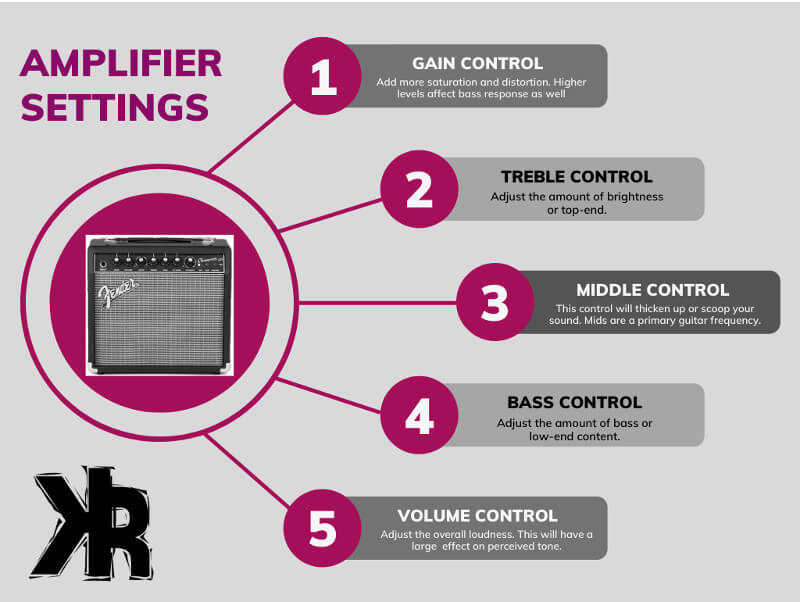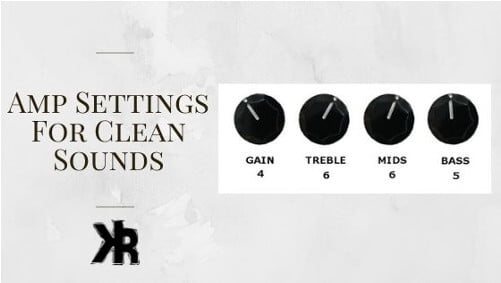Table of Contents
Getting a clean tone from an amplifier can be tough, especially when you know what you want to hear. Not every amplifier is made to provide pristine cleans, so you need to make sure you have the gear to help you along.
Setting your guitar amp for a great, clean sound can take some time. Once you know you have the amp for it, set it to the channel that can do clean tones best and use settings like:
- Gain: 3.
- Treble: 6.
- Mids: 7.
- Bass: 5.
- Presence: 5.
This Killer Rig article will explore some good guitar amp settings for clean sounds. Plus the equipment needed to help get them.
What is a Clean Sound?
A clean sound on an amplifier usually presents itself without overbearing distortion. Think of it as your guitar and amplifier working together without any added color. This can be difficult to achieve, as many amps are made to provide a bit of grit and grime.
To get a pristine, clean tone, you need to find an amp that provides good headroom. This is the amount of space between your guitar’s signal and the start of distortion.
Too little headroom and your amp will start to distort early. Too much will make it difficult to get any distortion at all.
The best way to find an amp with good headroom is to try it out for yourself. Head to a guitar store and ask to plug into a few different amps. Once you’ve found one that you like, take note of the settings and try to replicate them at home.
Different Clean Sound Settings
Now that we know what a clean sound is, let’s talk about how to get the most out of your guitar amp settings. Not everyone wants the same tone, and so each setting depends on what you are looking to get.
A few things to keep in mind before using settings to acquire a good, clean tone.
- The right guitar is needed for a pristine, clean sound. Anything with high-output pickups will provide a less-than-clean sound in some amps. Humbuckers with a normal output or single-coil pickups will be your best choice.
- You need an amplifier that is made for clean sounds. Some are designed to distort even when set low. So it’s important to make sure your amp is capable of doing so in the first place.
Each of the following examples will be for your amplifier’s clean channel or mode.
Check out our Pink Floyd amp settings here.

Brighter Clean Sounds
Are you looking for a brighter, pristine, clean sound that has the chime and spank? Then your settings will look different from that of someone who wants a warmer tone.
Your focus will need to be on treble and mids, while also paying attention to your gain setting. Higher gain settings can also add lower frequencies. This can be good or bad depending on several factors.
For example, if you are using a Stratocaster with single-coil pickups. You would be ok with a higher gain setting, as there are fewer low-end frequencies than a humbucker.
Good starting settings, in this case, would be:
- Gain: 4.
- Treble: 7.
- Mids: 7.
- Bass: 5.
This setting is a good starting place for a brighter tone. If you find you need to add any low end, try turning the gain knob first. This will also add a bit more mid-range content and possibly thicken it up without too much bass.
If you find it begins to break up, then use your bass control instead. Just keep in mind that the gain control is also a powerful part of how your EQ works.
Find our perfect Blues amp settings here.
Warmer Clean Sounds
If you are looking for a warmer tone that has more midrange focus, then you will want to back your treble off a bit. Too much can make your tone sound harsh and brittle. Especially with certain pickups.
Your goal should be to keep the midrange at around 5 or 6 to add some thickness while keeping your treble lower. This will give you a thick, warm tone that is still clear and articulate.
A good place to start would be settings like:
- Gain: 5-6.
- Treble: 4.
- Mids: 8.
- Bass: 6.
This setting should give you the warmth you are looking for. All without losing any of the midrange content. If you find it’s too dull, add a bit more treble.
You can also experiment with your gain setting to add a bit more thickness. Just be careful not to add too much as it can become slightly distorted.
But this can also be a good sound, depending on what you are looking to get for a tone.
Low Gain Clean Tone
If you are not looking for pristine cleans and want a bit of dirt, this can also be a great tone, especially for blues. There is nothing more satisfying than a clean sound that breaks up a bit when you really dig in. It also adds a great feel to the experience.
Some great settings for a bright, slightly broken up sound would be:
- Gain: 7.
- Treble: 7.
- Mids: 6.
- Bass: 4.
If it’s too bright, turn down the treble slightly and add some bass. This setting should bark a bit when you dig in or play more aggressively. Use your volume control on the guitar to clean it up when needed.
A good warmer sound with some dirt would be a slightly higher gain setting to 8. Treble down between 4 and 5. Then a slight bass increase to 5.
As you can see, more gain was used. I want to also add some low and mid-range content to the sound that is more organic. The neck pickup will also warm things up here, so try each one to see what you prefer.
Adding Effects
You can also add effects to your clean tone to further shape it. Reverb is always a good choice as it can add some space and depth to your tone without affecting the EQ too much.
Delay can also be a great effect to use, especially if you want to create ambiance or atmosphere in your playing. Just be careful not to overdo it.
Chorus is another good effect to use on a clean tone. It can add a bit of shimmer and movement that can bring your tone to life. Just don’t add too much, as it can become overwhelming quickly.
Make sure to add the effects after you have dialed in your clean sounds. This way they will only make them better and not overcomplicate the tone.
Check out this guide on amp settings and controls.
Tips For Getting Your Desired Tone With an Electric Guitar
A few other things that can help you get the clean tones you desire are to have and use the right equipment.
- For a bright, pristine clean sound, try using your bridge pickup.
- Warmer sounds might be better found on the neck pickup.
- Experiment with your gain control as it has a large effect on your EQ.
- Make use of the tone controls on your guitar, they can be powerful.
- Get the right amplifier and guitar for what you are trying to obtain.
- Effects can alter your sound, experiment with them sparingly.
Experimentation is going to be needed, as every guitar and amp will contribute in unique ways. Leave no knob unturned!
Conclusion
When aiming for a great, clean setting, take your time and experiment. There are many options available to you. Some players don’t take advantage of the controls or pickup options on their guitars. They lose out on some great tones.
If, at first, you don’t find your sound, leave it and come back the next day. When tweaking, sometimes your ears need a rest, so take your time and don’t get frustrated.
FAQs
How do you dial in a clean tone?
There is no one perfect way to dial in a clean tone. It will vary depending on the amplifier, guitar, and effects you are using.
A good place to start would be with the gain set around 4. Then the EQ controls set to noon. You can then adjust from there based on your preference.
Which electric guitar has the cleanest sound?
Every guitar will have a different sound, so it’s hard to say which one has the cleanest tone. It will depend on the pickups, tube amplifier, and effects you are using.
Some guitars are known for having a great clean tone. These are the Fender Stratocaster for bright and the Gibson Les Paul for a warmer sound.

